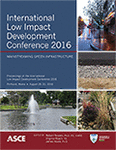International Low Impact Development Conference 2016
Update to Permeable Pavement Research at the Edison Environmental Center
Publication: International Low Impact Development Conference 2016: Mainstreaming Green Infrastructure
ABSTRACT
The EPA’s Urban Watershed Management Branch (UWMB) has been monitoring the permeable pavement demonstration site at the Edison Environmental Center, NJ, since 2010. This site has three different types of permeable pavements including interlocking concrete permeable pavers, pervious concrete, and porous asphalt. The permeable pavements are limited to parking spaces, while adjacent driving lanes are impermeable and drain to the permeable surfaces. The parking lot is instrumented for continuous monitoring with thermistors and water content reflectometers that measure moisture as infiltrate passes through the storage gallery beneath the permeable pavements into the underlying native soil. Each permeable surface of the parking lot has four lined sections that capture infiltrate in tanks for water quality analyses; these tanks are capable of holding volumes up to 4.1 m3, which represents up to 38 mm (1.5 in.) for direct rainfall on the porous pavement and runoff from adjacent driving lanes that drain into the permeable surface. Previous technical releases concerning the demonstration site focused on monitoring techniques, observed chloride and nutrient concentrations, surface hydrology, and infiltration and evaporation rates. This presentation summarizes these past findings and addresses current water quality efforts including pH, solids analysis, total organic carbon, and chemical oxygen demand. Current findings support earlier findings for pH, total organic carbon, and chemical oxygen demand where porous asphalt infiltrate values exceeded the infiltrate values of the other two permeable pavements; interestingly, porous asphalt suspended solids concentration is increasing with time.
Get full access to this article
View all available purchase options and get full access to this chapter.
ACKNOWLEDGEMENTS
The authors would like to thank Mr. Keith Kelty and other colleagues of the USEPA's Treatment Technology Evaluation Branch for overseeing the sample analyses and PARS Environmental Inc. for sample collection. The parking lot was constructed as a joint project with EPA Office of Administration and Resources Management and EPA Region 2.
REFERENCES
Brown, R. and Borst, M. (2013). ”Assessment of Clogging Dynamics in Permeable Pavement Systems with Time Domain Reflectometers.” J. Environ. Eng., 139(10), 1255–1265.
Brown, R.A., and M. Borst. (2014a). “Evaluation of surface infiltration testing procedures in permeable pavement systems.” Journal of Environmental Engineering, 140(3), 04014001.
Borst, M., and R.A. Brown. (2014b). “Chloride released from three permeable pavement surfaces after winter salt application.” Journal of the American Water Resources Association, 50(1), 29-41.
Brown, R.A., and M. Borst. (2015a). “Quantifying evaporation in a permeable pavement system.” Hydrological Processes, 29 (9), 2100–2111.
Brown, R.A., and M. Borst. (2015b). “Nutrient infiltrate concentrations from three permeable pavement types.” Journal of Environmental Management, 164, 74–85.
EPA (2010) “Surface Infiltration Rates of Permeable Surfaces: Six Month Update (November 2009 through April 2010)” U.S. Environmental Protection Agency, Office of Research and Development, Cincinnati, Ohio, Report No. EPA/600/R-10/083, June, 2010. (http://nepis.epa.gov/Exe/ZyPURL.cgi?Dockey=P1008CH4.txt)
Microsoft® Office Excel® 2013 (15.0.4805.1001) MSO (15.0.4805.1001) 32-bit Part of Microsoft Office 365 ProPlus.
National Ready Mixed Concrete Association (NRMCA) (2015) “Pervious Concrete Pavement Maintenance and Operations Guide” http://www.perviouspavement.org/downloads/pervious_maintenance_operations_guide.pdf
Robinson, D. A. (2014) “Relentless Winter: February 2014 Summary and Winter 2013/14 Summary” Office of the New Jersey State Climatologist, Dept. of Geography, Rutgers Univ., Piscataway, NJ.
Stander, E. K., Rowe, A. A., Borst, M., and O'Connor, T. P. (2013). “A novel use of time domain reflectometry in infiltration-based low impact development practices.” Journal of Irrigation and Drainage Engineering, 139(8), 625–634.
Wanga, K., Nelsen, D.E., and Nixon, W. A. (2006) “Damaging effects of deicing chemicals on concrete materials” Cement and Concrete Composites, 28 (2) 173–188.
Information & Authors
Information
Published In
International Low Impact Development Conference 2016: Mainstreaming Green Infrastructure
Pages: 135 - 142
Editors: Robert Roseen, Ph.D., Waterstone Engineering, Virginia Roach, CDM Smith, and James Houle, Ph.D., The University of New Hampshire
ISBN (Online): 978-0-7844-8054-0
Copyright
© 2017 American Society of Civil Engineers.
History
Published online: Oct 11, 2017
Authors
Metrics & Citations
Metrics
Citations
Download citation
If you have the appropriate software installed, you can download article citation data to the citation manager of your choice. Simply select your manager software from the list below and click Download.
